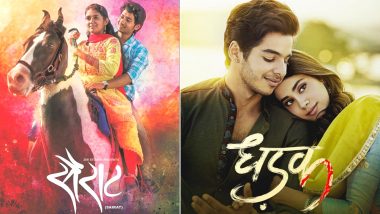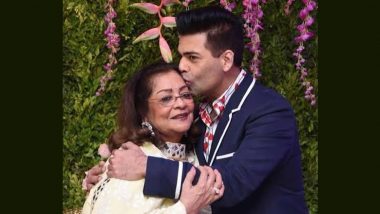There are many out there who have seen Dhadak and trying to defend the movie, saying it is unfair to compare it with Sairat. I ask - why not? Will they have the same sentiment if someone in Bollywood tries to remake Christopher Nolan's The Dark Knight? Why was the outrage then when Ram Gopal Varma tried to remake Sholay, even before RGV Ki Aag came out? Karan Johar knew he was inviting loads of criticism when he announced he was remaking 2016 Marathi blockbuster, Sairat. The only thing he had to assure that Dhadak, the so-called remake, lives up to the potential of Sairat.
No, I had no hopes as such, the moment he went on to cast two star-kids in the lead roles in Dhadak, as opposed to Akash Thosar and Rinku Rajguru in Sairat, who had no prior movie connections. Thankfully for Karan Johar, Ishaan Khatter and Janhvi Kapoor aren't bad performers, especially the former. But that doesn't change things. Having seen Dhadak, I can say with confidence that not only does the remake not justify its existence, it also ruins the soul of the Nagraj Manjule movie. In short, Dhadak is a pale, twisted replica of Sairat that is completely plastic in nature. It also makes me realise that Karan Johar and director Shashank Khaitan didn't really understand the cultural significance of Sairat and only saw it as a potential to launch two scions from the industry.
In case you are wondering how Dhadak might have ruined Sairat, these five examples might give you the hint!
Caste differences subverted
In Sairat, the caste differences and rich/poor divide between the protagonists were clearly defined. Parshya's father is a fisherman, while Archi's dad is a landlord with political ambitions. After their romance gets discovered is when their caste divide plays a bigger role. The greatest example of this is how Parshya's family has to rehabilitate from the village, after the upper caste makes their living hell and how his sister's marriage alliances get frequently broken even after three years of the incident.
In Dhadak, though, the hero is now the son of a lower-middle-class restauranteur. His father mentions a couple of times that they belong to a lower caste, but this is never hinted in the movie after that. More than the caste differences, it is the heroine's father's political ego that drives the wedge in the love story. After all, when has Bollywood made a good film that discusses castes and gives prominences to lower strata?
Underdeveloped secondary characters
In Sairat, some of the most likeable characters were Parshya's friends Sallya and Langdya. They gave so much context to the main love story, standing by their friend in any situation. Even though the second half completely ignores their presence, they still leave an indelible impression in the portions that we see them in, On the contrary, in Dhadak, Madhukar's friends are underdeveloped, even unwanted characters, who make below-the-belt jokes and end up being annoying sidekicks.
Also, Archi's brother Prince is a character who stands out, because his cruelty is defined by how young he is and also his arrogance. In Dhadak, Parthavi's elder brother has no such nuances to speak of. Then there is Suman Akka who gives refuge to Archi and Parshya in Sairat after they elope to Hyderabad. She is quite a feisty, well-defined character. However, in Dhadak she is replaced by an amiable Bengali couple who doesn't add much to the story.
Underdeveloped romance
The budding romance between Archi and Parshya in Sairat isn't just defined by two songs and some cute eye gestures. There is a lot more conversation happening, that is lacking in Dhadak. In the original film, there is pining shown between the couple, after getting separated by the girl's folks, which results in their hasty decision to elope. But Dhadak doesn't believe in wasting so much time on actual emotions, so Parthavi points a gun to her own head to make sure Madhu escapes the clutches of the police. Understandable, but what's not is her decision to run away with him.
Lack of understanding of poverty
Karan Johar's lack of exploring poverty in his movies comes in play in Dhadak, where the slums in the second half of Sairat (where the couple starts living in Hyderabad) is replaced by decent-looking lodges. The filthy makeshift toilets turn into common tiled ones. Archi's bottling factory job is now Parthavi's Just Dial call centre job, while Madhu ends up being a waiter at a restaurant instead of making dosas at a roadside stall. With these cosmetic changes, you really don't connect with the struggles of the couple in Dhadak.
The climax
Here's a little SPOILER for those who haven't see Sairat and planned to watch Dhadak. In the climax of Sairat, after what is thought to be a lovely reunion, Archi's kin kills her and her husband, and the aftermath of which is witnessed by their young toddler. A truly gut-wrenching ending!
In Dhadak's climax, the makers play with the expectations of those who watched Sairat. Here's the heroine is spared, while the hero and their child is thrown off the building to their deaths. And the movie ends with a message about 'honour killing' (which Sairat didn't even need to state). This sequence gives a clear idea that the writer has no clue what honour killing really means; here, the action feels more revenge-driven than a violent act to uphold the honour of the family. Also, how did the killers plan to leave the crime scene, since everything happened so fast?
So have you seen Sairat and Dhadak? Do you agree with our views expressed in this article? Share your thoughts in the comments section below.
(The above story first appeared on LatestLY on Jul 20, 2018 02:01 PM IST. For more news and updates on politics, world, sports, entertainment and lifestyle, log on to our website latestly.com).













 Quickly
Quickly





















